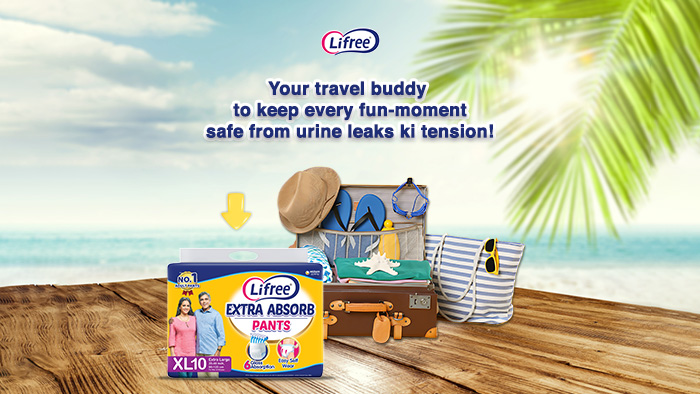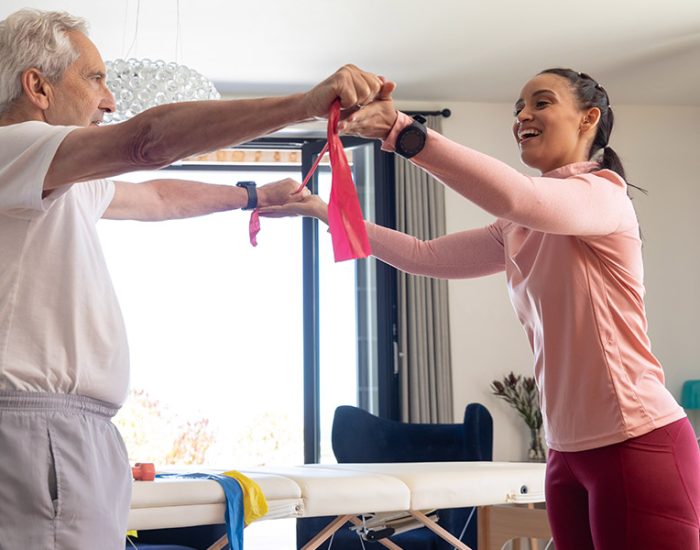What are the best ways to manage incontinence while travelling
Summer is here, which means longer days, sunny afternoons, summer breaks and trips. Travelling brings an exciting and enriching experience but it can become challenging for individuals managing incontinence. If you are one of the many who is struggling with overactive bladder or incontinence, the idea of sitting in the car or any public transport for too long might be daunting and discouraging. You can imagine all the uncomfortable and embarrassing situations that can occur during such trips with family. Therefore, you think travelling is not worth the risk.
Many of the patients or their families feel the same way. However, with careful planning and the right products you can manage incontinence very smoothly during travel.
Here’s a guide to regain your independence and confidence while travelling ensuring a stress-free and enjoyable trip.
What are the incontinence challenges faced during travelling?
Understanding the incontinence hurdles during travelling
The inconvenience of incontinence is both emotional and physical, especially during travel when it disrupts the seamless experience. Searching for a restroom constantly can be embarrassing and can lower your confidence as well. In an unfamiliar environment or during a long journey, it’s a challenge to access clean restrooms. The limited access can heighten anxiety and discomfort. Also, the fear of leaks and accidents impacts the confidence and ability to fully engage in the travel experience. This can further alter schedules and impact the overall itinerary & travel experience. An individual experiencing incontinence can feel isolated, embarrassed & self-conscious during such situations.
Travelling long distances, using limited restroom facilities, and being afraid of leaks can be daunting. However, with practical planning & Adult Diaper Large, you can effectively address incontinence while travelling.
View this post on Instagram
Best ways to manage incontinence while travelling
1. Planning: Research your destination, and transport facilities to create a seamless itinerary keeping your incontinence in mind. If you plan you can alleviate the anxiety and you will have timely access to washrooms, breaks, food and rest facilities.
2. Choose the Right Diaper: Choosing the right products in your daily life to manage incontinence is crucial. Your body is habitual of the products and your lifestyle which you can follow during your travel. Lifree Adult Diapers comes in all different sizes which can help you in long trips and short breaks as well. Adult Diapers Large & Adult Diapers Medium are mostly the right choices to take with you during a long journey. Its advanced absorbent cores and leak-proof technology protect against leaks.
3. Stay Hydrated: Don’t dehydrate yourself because of the fear, make sure to keep yourself hydrated throughout your journey. However, make sure to not have excessive fluid intake and to eat other things to keep yourself hydrated as well. This way you can stay hydrated and avoid frequent washroom visits.
4. Plan Bathroom Breaks: Do not skip good washroom pit stops during your journey to stretch your legs. You can utilise these breaks to visit restrooms and can also change your diaper. Take advantage of the station washroom, restaurants and public facilities. However, you don’t require frequent diaper change, if you use an Adult Diaper Large size.
View this post on Instagram
5. Pack a Travel Kit: Prepare a travel kit for better management of your incontinence situation. This kit should include all your essentials and should be easily accessible to ensure quick access to necessary items at any given time. Keep lots of Adult diapers Large and Adult diapers Medium sizes to avoid any problems during the whole journey till you are back home. Add wipes, disposable bags, hand sanitiser and 1 set of spare clothing. Also, include your medical supplies, medication and your doctor’s contact information for emergencies.
6. Stay Positive: Maintain positive behaviour and attitude throughout the journey because minor inconveniences may keep occurring but it won’t be a problem if you are prepared to overcome the challenges. Your focus should be only on enjoying the travel and having a lovely time with your loved ones not on checking the leakage.
7. Be Flexible: Keep your itinerary flexible and be adaptive towards section options as needed. This will ensure your comfort and well-being throughout the journey.
Your incontinence condition shouldn’t hold you back from taking that road trip this summer. The trip may seem intimidating at first, but with some planning and preparation, you can enjoy it.
FAQ’s
2. What type of incontinence products are best for travel?
The best incontinence products for travel are those that balance comfort, discretion, and high absorbency. Pant-style adult diapers are often recommended for travellers because they are easy to wear, remove, and change even in tight spaces. Choose products with leak guards and odor-control features to maintain freshness during long journeys. If travelling for several hours, opt for high-absorbency diapers designed for extended wear to reduce frequent changes. Slim-fit designs help you feel comfortable under regular clothes without bulkiness, giving you freedom to move easily. Carry individually packed products for hygiene and convenience. For people who require assistance, tape-style diapers may be preferable. Packing extra liners or booster pads can also provide added protection on days with heavy leaks. Ultimately, the product choice depends on your travel plans, mobility, and personal comfort preferences.
3. How can I discreetly manage incontinence during a trip?
Managing incontinence discreetly during a trip involves careful planning and a few simple strategies. Wear clothing that is easy to remove for quick changes, such as loose-fitting pants. Use pant-style adult diapers that resemble regular underwear for better discretion. Always carry a small travel bag with wipes, disposable bags, and spare diapers for easy access. Look for private, accessible restrooms in airports, stations, or hotels ahead of time to reduce stress when you need to change. Opt for darker clothing to make any potential leaks less noticeable. Using products with strong odor-locking technology can also help you stay fresh and confident throughout the journey. If you’re travelling with others, informing one trusted companion can make it easier to get help when needed. These small steps allow you to stay comfortable and discreet while enjoying your travels.
4. How many incontinence products should I pack for travel?
The number of incontinence products to pack depends on the duration of your trip, access to stores, and the severity of your condition. As a general guideline, calculate your average daily usage and add at least two to three extra products per day to handle unexpected delays or heavier leakage. For longer trips, consider packing a combination of pant-style diapers for daytime use and higher-absorbency products for overnight protection. Individually wrapped diapers are more hygienic and easier to carry discreetly. If your travel destination may not have reliable access to suitable products, pack enough for the entire trip. It’s also wise to keep a day’s supply in your carry-on bag or a small kit for quick access. Having extra products on hand ensures you feel secure, comfortable, and stress-free throughout your journey.
5. How do I handle changing incontinence products while travelling?
Changing incontinence products while travelling can be made simpler with the right preparation. Always carry a small, discreet changing kit that includes wipes, disposable bags, and fresh diapers. Plan to change products in accessible restrooms, such as those in airports, restaurants, or gas stations. For long trips, opt for pant-style diapers that are easy to pull on and off, making changes quicker and more convenient even in small restroom spaces. Use disposable bags to safely store used products until you find a trash bin, ensuring hygiene and discretion. If you’re travelling with assistance, choose tape-style diapers that are easier for caregivers to manage. Schedule regular restroom breaks to change proactively rather than waiting for discomfort or leaks. With the right products and tools, changing during travel becomes a stress-free part of your routine.
6. Can I stay hydrated without worsening incontinence while travelling?
Yes, staying hydrated is essential, even for those managing incontinence. Dehydration can actually make bladder problems worse by concentrating urine and irritating the bladder, leading to more urgency or discomfort. The key is to drink water in moderate amounts throughout the day instead of consuming large amounts at once. Avoid bladder irritants like caffeine, alcohol, and fizzy drinks, especially before or during travel, as they can increase leakage. Schedule fluid intake so you can plan restroom breaks around your travel route. For instance, sip water consistently rather than gulping before boarding a flight or bus. Hydration helps maintain bladder health, reduce infections, and prevent constipation, which also impacts bladder control. Carrying a refillable water bottle allows you to monitor your intake and stay hydrated without overconsuming. This balance ensures you feel better while managing incontinence effectively during travel.
7. How can I manage incontinence on flights or long journeys?
Long journeys require extra planning for managing incontinence effectively. Before travelling, wear a high-absorbency, pant-style diaper designed for extended wear. Carry an extra change of products, wipes, and disposal bags in your carry-on for easy access. Request an aisle seat on flights or buses to make restroom visits less stressful. For trips exceeding several hours, consider using booster pads inside your diaper for added absorbency. Use restroom breaks strategically before boarding and whenever available during stops. Limit intake of bladder irritants like caffeine before the journey. Wearing comfortable, loose-fitting clothes allows you to change products more easily in small spaces. On flights, inform cabin crew discreetly if you may need assistance. These steps provide comfort and confidence, making long-distance travel manageable even with incontinence.
8. What should I include in my incontinence travel kit?
A well-packed travel kit makes managing incontinence easier. Essentials include enough absorbent products for your trip, plus extras for emergencies. Add disposable wipes for hygiene, odor-locking disposal bags for used products, and a spare set of underwear or clothing. Include a hand sanitizer for situations where sinks are unavailable. Carry individually packed diapers for easier handling. A small, discreet pouch keeps items organized and within reach in your handbag or carry-on. For overnight trips, pack high-absorbency diapers to reduce nighttime changes. Include a travel-friendly underpad if you’re staying in hotels to protect bedding. If you take medications that impact bladder health, bring them along with a doctor’s prescription in case of emergencies. Having these essentials ready gives you peace of mind and makes travel smoother and stress-free.
9. How can I reduce anxiety about travelling with incontinence?
Anxiety about travelling with incontinence is common, but preparation can make it manageable. Begin by planning ahead—pack enough incontinence products, scout restroom locations, and build extra time into your travel schedule. Use reliable, high-absorbency products to prevent leaks and discomfort. Informing a travel companion about your needs can help you feel supported. Practice relaxation techniques like deep breathing to calm nerves before and during travel. Choose comfortable, darker clothing to feel more confident in public. If you’re flying or travelling long distances, communicate discreetly with staff for assistance if needed. Breaking your trip into manageable segments with scheduled breaks reduces stress. Remember, you’re not alone—many people travel successfully with incontinence every day. With the right mindset and preparation, you can enjoy your journey confidently and without fear of embarrassment.
10. Should I consult a doctor before travelling with incontinence?
Yes, consulting a doctor before travelling with incontinence is a wise step, especially if your symptoms have changed recently or you’re planning a long journey. A healthcare provider can review your condition, adjust medications if necessary, and provide tips for managing incontinence during travel. They may also recommend suitable incontinence products based on your needs and lifestyle. If your travel includes long flights or remote destinations, your doctor can help prepare you for limited restroom access or changes in routine. They might also provide guidance on diet, fluid intake, and exercises to support bladder control. In some cases, a medical note explaining your condition can be useful when travelling through airports or customs with large quantities of hygiene products. A quick consultation ensures you’re fully prepared for a stress-free journey.






















